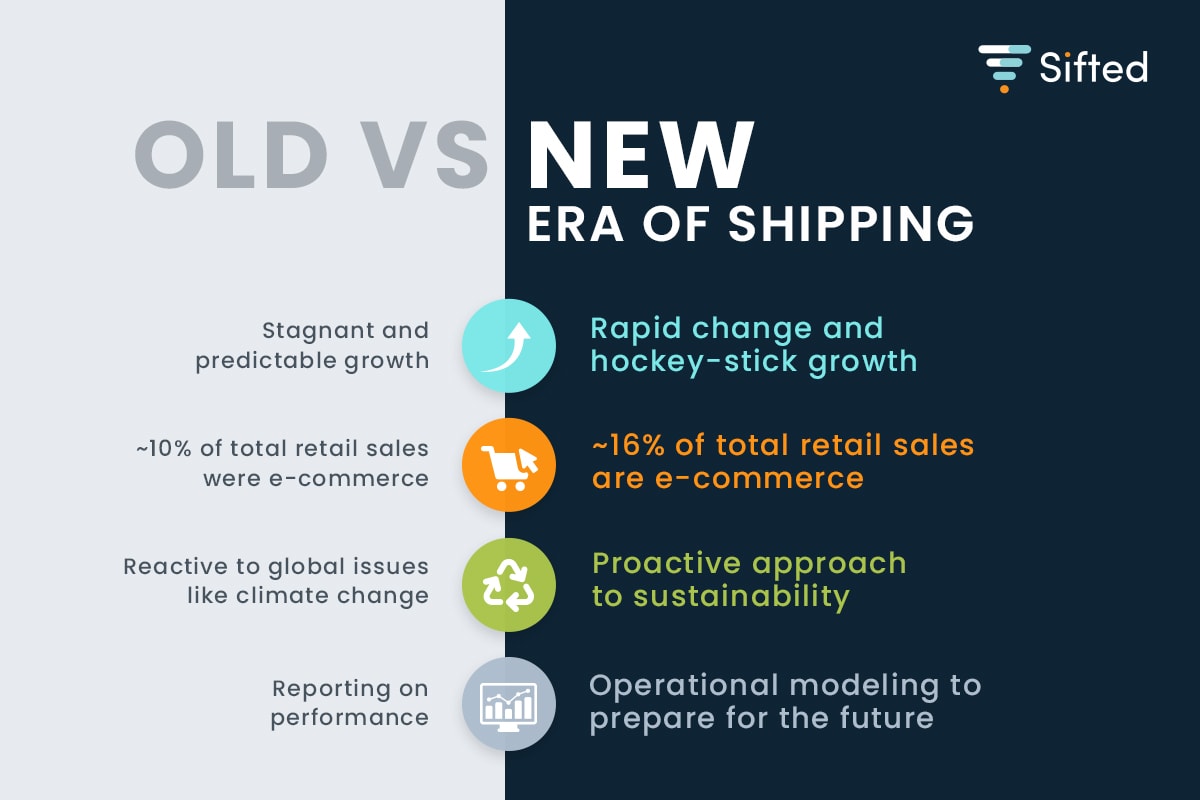The once-stagnant logistics industry has undergone rapid change in recent years. The 2017 electronic logging device mandate sparked something of a technological revolution within the industry. This focus on tech — coupled with outside forces ranging from consumer demand to climate change — has fostered an environment of innovation. Companies that are slow to adapt to new expectations are likely to be left behind. Shippers are no exception.
E-commerce boom
Between the second quarter of 2019 and the same quarter of 2020, e-commerce sales soared from 10.8% to 16.1% of total retail sales.
Consumer retail spending in the e-commerce space has been climbing for decades. Historically, e-commerce has experienced slow but steady growth. According to the U.S. Census Bureau, e-commerce spending tends to climb about 1% on a year-over-year basis. Last year’s dramatic results were a pandemic-fueled outlier.
“If you look at transportation as a whole, it is on a hockey stick growth curve. If you look at parcel and e-commerce within parcel, the amount of growth over the last year has been wild,” Sifted Chief Revenue Officer Caleb Nelson said. “The rate of growth has been so drastic that capacity is struggling, leaving shippers in a tight spot.”
While uncharacteristically speedy growth in the e-commerce space was undoubtedly driven by the coronavirus pandemic, the trend is expected to continue even as consumers resume many of their pre-pandemic habits. That means the pressure is on retailers and transportation companies alike to adapt without sacrificing customer service.
“A lot of people were forced to shop online during the pandemic. Since then, there has been a major shift indicating that individuals are willing to go outside their comfort zones and do more online shopping,” Nelson said. “The resulting strain on capacity has carried through to shippers and consumers. The pressure is on shippers to find areas of cost savings and deliver a better customer experience.”
Going green
In addition to grappling with the e-commerce surge, many shippers are searching for ways to reduce their carbon footprint without compromising customer service. Consumers are asking shippers to reckon with their impact on the environment and adopt greener manufacturing and transportation practices.
“Shippers often ask us how they can reduce their carbon footprint. It’s important to their customers because they want to do business with companies that share their same values,” Nelson said. “Reducing top zones, shipping more locally and reporting on fuel surcharges all factor in when a client is trying to understand their carbon footprint.”
Climate change will remain a hot-button issue, and this pressure is not expected to let up anytime soon. To adjust to the evolving landscape, shippers will need to move past age-old tendencies to be reactive to the logistics industry and economic changes and embrace a more proactive approach.
Data’s power in the logistics industry
To meet that imperative, shippers often need help visualizing their data to identify areas of opportunity.
“Most shippers know that there are additional areas of cost reduction that could be embraced within their businesses,” Nelson said. “They may have a gut feeling about what needs to change but could be lacking the modeling of their data to confirm those gut feelings.”
That is where Sifted comes into play. The company’s data-powered Logistics Intelligence (LI) platform helps shippers uncover areas of cost saving through optimization and modeling. This approach takes data beyond simple reporting, making it interactive. Sifted gives shippers superior clarity, uncovers hidden costs and identifies promising growth opportunities.
“Reporting is often touted, but there is a difference between reporting and modeling,” Nelson said. “Modeling allows you to play with your data in a sandbox, running what-if analyses. This is one of the major differences between Sifted and others. We provide a living, breathing simulation using data.”
Shippers who have a deep understanding of their data, with access to comprehensive models, are the ones most likely to win in today’s shipping environment. These companies are more efficient, allowing them to offer best-in-class pricing and higher levels of customer service.
Feel empowered to stay ahead in the new era of shipping with Logistics Intelligence (LI).















